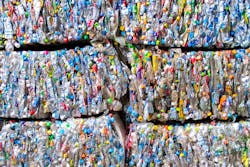From the Fall 2023 issue of Plastics Recycling.
By Ron Shinn
Companies that buy bales of scrap plastic to make recycled plastic pellets have horror stories about things they find in bales – concrete blocks, big chunks of metal and even dead animals.
But most recyclers learn the suppliers they can trust to provide the acceptable bales they need to make recycled resin for their specific customers.
That seems like a workable business model, but a recent report commissioned by The Alliance to End Plastic Waste (AEPW) argues that model is broken because it does not include standards for bale and recycled pellet content.
Knowing what’s in a bale is necessary for recyclers to efficiently create flake or pellets that meet high quality content standards. The recyclers’ current business of mostly designing one bespoke resin for a specific customer instead of a resin that is standardized for a specific product holds back use of recycled plastic, according to the report.
What is a good-quality bale? It has to support the end use of the resin, but might include knowing non-polyolefin content, non-plastic content, moisture, color and level of impurities.
What is a quality pellet? Depends on the application, but considerations might include ash content, density, filtration, melt index, moisture content, odor, pellet color, polyethylene or polypropylene content, flex modulus and tensile strength.
The study suggests that if the industry can decide on specific recyclate standards for various applications, recyclers will have more customers for their material. Circularity is improved as well.
The report looked at the European plastic recycling industry, which is arguably already more regulated than the U.S., as the best market to prove the model.
What would such a strategy mean for U.S. recyclers?
Scott Trenor, technical director of the Association of Plastics Recyclers (APR), said transparency in the recycling marketplace benefits everyone, but there are problems with the model.
“If you go to recyclers’ websites, some have their material specifications listed and others just say ‘Contact us,’” Trenor said. “That makes it difficult for purchasing agents and product designers to find suitable recycled content that meets their requirements.
“Meeting a universal standard for some recycled resin would depend on where the recycler is on the spectrum of reclaimers,” Trenor said. “One who takes bales and pelletizes the resin to those on the other end of the spectrum who take bales and compounds the resin. It is easier to meet specifications for those on the blending and compounding side,” he said.
He said the recyclers who buy bales and process pellets might have difficulty meeting content specifications without investing in additional equipment.
Trenor said there are already hurdles to increasing recycled content in plastic packaging and adding specific requirements for resin content might be another excuse for brand owners to not use recycled content.
It is unclear who would develop bale and pellet standards in the U.S. market. Trenor said APR and the Institute of Scrap Recycling Industries (ISRI) would be the best candidates for creating bale specifications. For pellet specifications, “it would probably have to be ASTM International, but that is pretty far from their typical reach,” he said.
Is this proposed model just a solution looking for a problem? It has some of those characteristics. The study projects a 4 percent to 20 percent price improvement for recycled resin, which Trenor says probably would not pay for recyclers’ needed investment.
Ron Shinn, editor
About the Author
Ron Shinn
Editor
Editor Ron Shinn is a co-founder of Plastics Machinery & Manufacturing and has been covering the plastics industry for more than 35 years. He leads the editorial team, directs coverage and sets the editorial calendar. He also writes features, including the Talking Points column and On the Factory Floor, and covers recycling and sustainability for PMM and Plastics Recycling.
